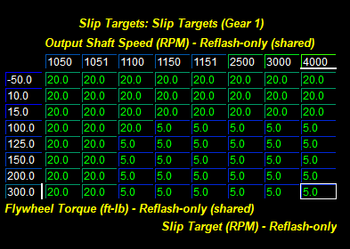This is a brief overview of controlling torque converter lockup on Ecoboost Mustang for increased high demand performance. Torque thresholds and ramp rates will not be covered, further investigation will be required (see toggle usage in overview). Topics will be broken out into the following sections:
- Overview
- Converter Schedules
- Converter Pressure
- Slip Target
- Unconditional Unlock sources and timers
Overview:
The primary activation threshold for TCC lockup is controlled by the converted schedules. There are schedules for each drive mode and they return an output shaft speed above which a TCC lockup will be requested. Once a lockup has been requested the system will begin to supply pressure to the lockup clutch unless the lockup is blocked. The primary blockers for TCC lockup are torque limits, unconditional unlock timers, or theparameter. Further investigation will be required for the torque limit conditions but these can be disabled by un-checking the toggle. An unconditional unlock state can be set by various conditions and will apply a delay for TCC lockup based on the unconditional unlock source as monitored by . TCC lockup request can be monitored by and actual lockup is best monitored by . TC Lockup Status will be 0 in an unlocked state, and 1 or 3 in a locked state. Further investigation will be required to find what determines a 1 or 3 lock state but It is not necessary for this state to be 3 to consider the TCC as locked, TC Slip Actual is a better representation of this.
Converter Schedules:
Converter Schedules define an output shaft speed at which the TCC will lock and unlock. There exists a table for each drive mode, "Base" for drive, "SST" for manual shift mode, and "Sport" for S mode. An adjustment needs to be made to how we present this information as the "Lock" rows are not used and the "Slip" rows are used as a lock threshold. The x-axis is in accelerator breakpoints and uses the Shift Schedules: Pedal Breakpoints (Upshift) and Shift Schedules: Pedal Breakpoints (Downshift) tables for lock and unlock pedal position percent to breakpoint conversion respectively. The SST schedule shown below has been modified from stock to command TCC lockup above 520rpm and 820rpm output shaft speed for 1st and 2nd gear respectively while above 65% pedal position. Compared to the stock values of 6200, this allows the TCC to lockup in first and second when it would not have previously. Output shaft speed can be converted to vehicle speed by dividing OSS by
Converter Pressure:
TCC lockup pressure will determine how hard/fast the TCC locks and is controlled based on requested torque capacity and target vs actual slip. Increasing and will increase the response to TCC slip and reducing slip target will result in a harder lock.
Slip Target:
Slip targets specify how much TCC slip is desired, this can be monitored with . Decreasing slip targets will result in more pressure to the TCC in order to lock the converter.
Unconditional Unlock sources and timers:
There are various unconditional unlock sources that will block a TCC lockup request. These sources are set when the conditions for the source are met, a delay is initialized and counted down and TCC lockup will not be allowed until it has expired. There are three important delays that will likely need to be adjusted, Unconditional Unlock Delay (not yet defined), TCC Apply Delay (Upshifts), and TCC Apply Delay (Downshifts) (note: these are currently labeled backwards). TCC Apply Delays activate on shifts and will generally be accompanied by an unconditional unlock source of 17. The current unconditional unlock source can be monitored by , its source definition and delay is as follows:
- 0 - No active delay in process - Zero Delay
- 1 - Mechanical failure - Unconditional Unlock Delay
- 2 - Non forward gear - Unconditional Unlock Delay
- 3 - ETC Shutdown - Unconditional Unlock Delay
- 4 - Traction Control - Unconditional Unlock Delay
- 5 - TCC Solenoid Failure - Unconditional Unlock Delay
- 6 - Speed Ratio Low - Unconditional Unlock Delay
- 7 - Speed Ratio High - Unconditional Unlock Delay
- 8 - Speed Ratio High with Open TCC - Unconditional Unlock Delay
- 9 - Decel - Unconditional Unlock Delay
- 10 - Low Vehicle Speed - Unconditional Unlock Delay
- 11 - Low ECT - Unconditional Unlock Delay
- 12 - Engine Speed Targetting Active - Unconditional Unlock Delay
- 13 - Tip-In - not defined
- 14 - Tip-Out - not defined
- 15 - Brake - not defined
- 16 - Idle - not defined
- 17 - Gear Shift - TCC Apply Delay (Upshifts) or TCC Apply Delay (Downshifts)
- 18 - Gear Shift - TCC Apply Delay (Upshifts) or TCC Apply Delay (Downshifts)
- 19 - ABS - Unconditional Unlock Delay
- 20 - Engine Brake Gear Shift - Unconditional Unlock Delay
- 21 - TCC Lock to Unlock - not defined













